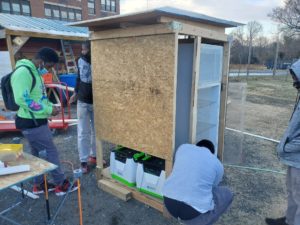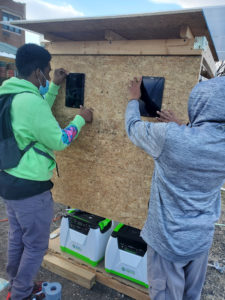Teacher Harry Preston leads STEM club to help community with a problem-based learning project. (WMAR-2 News, Baltimore)
National testing data proved how badly the pandemic years affected school districts across the country, especially in the STEM disciplines that offer today’s students pathways to the jobs of the future. The fallout — burned-out teachers and students, as well as teacher shortages — hit especially hard in underserved communities like my hometown of Baltimore. Problem-based learning can be a solution.

The New Teacher Project, which seeks to improve educational outcomes for public schools, has shown that creating a pipeline of effective teachers is one of the best ways to raise student performance and bolster education. Students with just one top teacher are more likely to attend college and earn a higher salary. And teachers who seek professional development opportunities set the example that you never stop learning.
At Green Street Academy in Baltimore, where I’m a computer science teacher, I’ve witnessed how alternative approaches to education — in particular, problem-based learning techniques — motivate and engage teachers as well as students, encouraging that strong teacher pipeline that we so desperately need today. PBL can unite teachers and students, inspiring innovation to address real-world challenges by working in groups to solve an open-ended problem and move toward hands-on solutions.
How problem-based learning makes a difference
Last summer, I had the opportunity to connect with more than 30 educators at Solve for Tomorrow Teacher Academy to discuss how to best engage students, make them excited and encourage learning outside of the classroom. In this forum, our group of teachers recognized that, as opposed to just talking to students, our job is to support their learning and change our processes to best serve them.
According to the Hun School of Princeton, problem-based learning promotes self-learning, allows students to develop transferable skills, improves teamwork abilities and encourages intrinsic rewards. At Green Street, we find our students are more engaged in our lessons and excited to learn new subjects when they are given the opportunity to learn through hands-on experiences.
One challenge for schools is finding scalable, turnkey frameworks for such activity. You can start by looking at academic sources, such as the Innovation Institute of the University of Illinois, for their input on problem-based learning techniques. Another approach is cross-checking the results from online searches for “STEM competitions.” Your network of colleagues and their social media feeds are increasingly important sources. We found our model in the annual Solve for Tomorrow nationwide public school competition, which encourages students to use STEM to solve real-world, community-based issues like climate change, the opioid crisis, school safety, mental health and bullying.
Finding solutions to community problems

Our Solve for Tomorrow team chose to address food disparities and insecurities by developing an automated, emergency food pantry powered by wind and solar to provide community residents access to safe, healthy and fresh produce on a regular basis.
At each step of the way, the students learned the importance of having agency, contributing to the decisions that needed to be made and drawing on their own experiences to frame their conclusions.
When our students landed on their food pantry as a way to solve the problem of multiple food deserts in our Baltimore community, several argued that a single pantry wasn’t enough. That sparked the idea of constructing a mobile pantry that could be moved between neighborhoods. While at first the students had differences of opinion about mobility, their discussions ultimately forged a consensus around creating a unit that could serve a number of locations. That give-and-take highlighted the importance of individual participation. One member of the class told a local television reporter covering the project that the project was personal, explaining that his family typically had to walk long distances to get food because there were no grocery stores near his home.
Community embraced students’ success
Constantly innovating, my class moved through each phase of the competition and ultimately was named a national finalist, winning $50,000 in technology. The process included an invitation to participate in a live pitch event in New York City, where our team presented their project to a panel of judges. While that technology prize was incredible and will truly make a difference for students within our school, the experience of participating in the program was priceless for my students.

The support their solution received from the larger Baltimore community, including the positive coverage in local media, provided perhaps the longest-lasting impact of their participation: an enduring lesson in their power as individuals. Providing students opportunities to have a voice in real community issues allows them to see the change they can create in the world and in the lives of their family, friends and community.
Since introducing problem-based learning techniques in my classroom, several of my students decided to continue their education and go to college to study topics related to STEM.
I’ve learned that I’m a better version of myself as a teacher when I take the opportunity to improve my skills through professional development programs. They have taught me how I can give students opportunities beyond learning in a classroom and how to look for ways that students can tackle problems and apply their knowledge, helping them to better retain the information we’re trying to convey. That’s the definition of a win-win.
Harry F. Preston V teaches computer science at Green Street Academy in Baltimore and is the director of innovation for the school’s Innovation Center, where the Green Street Academy STEM team was one of 10 national finalists in Samsung’s Solve for Tomorrow competition in 2021-22. Preston previously worked for Baltimore City Public Schools and was AIAA Baltimore Teacher of the Year in 2014.
Opinions expressed by SmartBrief contributors are their own.
_________________________
Subscribe to SmartBrief’s FREE email newsletter to see the latest hot topics on EdTech. It’s among SmartBrief’s more than 250 industry-focused newsletters.